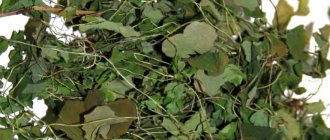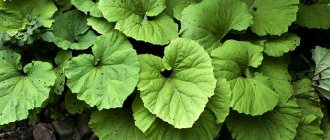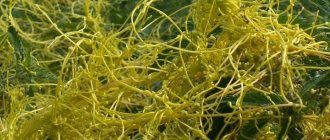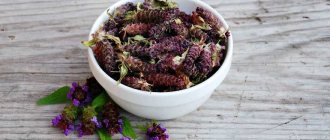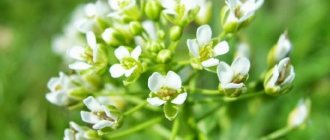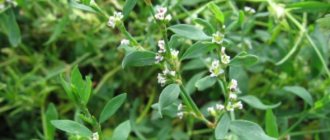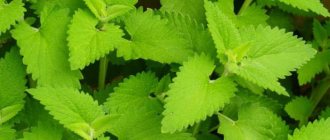Budra ivy (in common parlance is often called catnip, dognip, garuchka, lambswort, podpirukha, mole mint) is a herb whose medicinal qualities and versatility were noticed by ancient healers.
Despite the presence of toxic elements, plant materials are widely used in traditional medicine. Decoctions and tinctures are used in the treatment of colds, coughs, and even cancer.
A prerequisite before using the product is to carefully study the characteristics of the plant and the rules of use. Mistakes made can result in a number of side effects or even severe poisoning!
Brief description of ivy budra, growth
Budra ivy is a perennial plant, not exceeding 25-30 cm in height. The stem is creeping, branched, bare near the base, covered with sparse hard hairs at the apex. The rhizome is powerful, creeping, up to half a meter long.
The leaves are heart-shaped, rounded, with rather thick, short petioles. The flowers are small, purple or lilac. Flowering begins in the last month of spring and lasts until early July. It ends with the formation of small fruits and nuts.
The plant is widespread in the European part of the Russian Federation, often found in the Caucasus, the Urals, the Far East, and even the Far North. Feels most comfortable in the southern regions.
Thickets of dogmint occupy large areas in wastelands, forest edges, and the banks of reservoirs. Grass usually prefers shaded areas, but can easily grow in sunny meadows provided there is sufficient moisture in the soil.
How and where does Budra grow?
Those plants that are not widely used in medicine, that grow under our feet and do not have any special external characteristics, do not attract our attention. And everyone has seen ivy-shaped Budra more than once. After all, it grows everywhere - in gardens and orchards, on forest edges, among bushes, in fields and water meadows. Remember how stems rise from the grass, planted with leaves that have a rounded heart-shaped shape, covered with sparse but rather long hairs. And in the axils of the leaves small two-lipped blue or delicate lilac or purple flowers bloom. Budra ivy belongs to the Lamiaceae family. This is a herbaceous perennial plant. Its stem is quite long - 60 centimeters in length. those stems on which flowers appear rise in height. Budra ivy blooms all summer, from June to August. This plant has one remarkable feature. Some stems, along with the leaves, remain green in winter and are buried under the snow. But in the spring, when the snow cover melts, these stems see the sun in a new - crimson-violet - guise. This is the transformation.
Rules for collecting, drying, storing herbs
For medicinal purposes, only the above-ground part of the bud is used. It is recommended to go collecting medicinal plant materials during the growing season - from spring to late summer. In the fall, you should not prepare a valuable component of home medicines - the perennial loses some of its medicinal properties in preparation for the winter.
Cut the grass with sharp pruners or scissors and put it in a basket. At home, rinse the plant material under running water and place it on baking sheets to dry. If the grass is too large, chop the stems a little - this will speed up the drying process.
Dry the plant component under canopies, in the attic, in a ventilated, dry room. A prerequisite is good ventilation. You can use an oven or a special dryer. High temperatures are not recommended - there is a risk of destruction of a number of useful elements.
Use glass jars and plastic containers to store prepared plant materials. If there is a cool room with low humidity, it is allowed to pack the herbs in canvas bags. The shelf life of the herb is up to two years.
Article for you:
Medicinal properties of the mullein plant and its use in folk medicine
The medicinal qualities of the herb are not recognized by official medicine. You will have to collect plant materials yourself.
Useful properties of dog mint, indications
Due to the rich content of useful elements (the grass is replete with amino acids, tannins, resinous substances, essential oils, vitamins, ascorbic acid), herbal remedies have numerous healing qualities.
Among the beneficial properties are diuretic, antiseptic, anti-inflammatory, analgesic, and expectorant. Budra also contains elements that actively affect the skin - home remedies promote tissue regeneration, cope with inflammation, dermatitis, and heal severe burns. It is recommended to use herbal decoctions and tinctures for a number of diseases, including:
- severe cough (bronchitis, colds, bronchial asthma, tuberculosis);
- diseases of the digestive system (gastritis, ulcers, enteritis);
- diseases of the genitourinary and reproductive systems;
- runny nose;
- varicose veins, muscle tissue spasms;
- throat diseases;
- hearing loss;
- dropsy;
- diseases of the dermis (scabies, rashes, eczema, ulcers, psoriasis).
It is also recommended to use homemade compositions in the postoperative period, after fractures, severe bruises, injuries - the active components start the regeneration process and relieve pain.
Preparing the tincture
The medicinal properties of ivy bud are manifested in tinctures prepared from it. They can be prepared with alcohol and vinegar. We remind you once again that when using this plant, you must strictly observe the proportions and dosage.
Here are a few recipes.
1. On vodka. Any glass container with a lid is suitable. One part of collected, washed and chopped fresh herbs is poured with ten parts of vodka. Close the container tightly. Place it for 10 days in a place inaccessible to the sun and children. At the end of this period, the tincture is filtered through a cloth and placed in the refrigerator. Take it orally, 20 drops before meals. This remedy helps with problems with the gastrointestinal tract, genitourinary system, headaches, and infectious diseases.
2. On vinegar. 20 grams of dry raw materials are placed in a container and filled with ordinary vinegar, of which 100 ml (half a glass) is taken. Leave for a week, shaking occasionally. The product is used externally to treat skin diseases.
We recommend reading: HCG table after embryo implantation
3. Lotion. Take equal quantities (any) of vodka and budra decoction and mix. It turns out to be a good remedy for acne, which should be used to wipe problem skin.
- Colds (helps to avoid serious consequences of hypothermia).
- Bronchitis.
- Pneumonia.
- Tracheitis.
- Bronchial asthma.
- Bronchopneumonia.
- Sore throat (drink tea and gargle).
- Sinusitis (take orally and drop into the nose).
- Problems with the thyroid gland.
- Dropsy.
- Liver cancer (as part of complex therapy).
- Any inflammation of the genitourinary system.
- Tuberculosis.
- Any ailments accompanied by cramps (relieves spasms).
- Diseases of the intestines and stomach.
- Haemorrhoids.
- Helminthiasis.
- Stones in the kidneys.
- Headache.
- Coughing.
- Scrofula.
- Dermatitis.
- Gout.
- Toothache.
- Stomatitis, gingivitis.
- Hearing impairment.
- Varicose veins
- Has a healing effect on fractures.
- Externally used for burns and other injuries.
Treatment of cough with budra infusion
For severe coughs that occur due to tuberculosis, colds, and bronchitis, it is recommended to use a rich infusion of dog mint. The product helps to liquefy mucus, expectoration, and has a beneficial effect on the respiratory system. The infusion will also relieve discomfort on the mucous membranes of the throat that occurs during coughing attacks. Step-by-step folk recipe:
- Chop the herbs (you will need a tablespoon of plant mass).
- Boil water (600 ml) and steam the herbal mixture.
- Leave to brew, close the container with a lid, and wrap in a towel.
- Strain after an hour.
Take five times a day, dosage – 50 ml. Store in the refrigerator, and be sure to warm up the infusion before use - cold liquid can cause additional discomfort and slow down the work of the active substances.
Duration of treatment is up to two weeks. This period is enough to completely cope with even a severe cough. If the attacks do not lose intensity, it is recommended to go to the doctor, an additional examination will allow you to find out the cause - it happens that a cough indicates a disease that requires serious drug treatment.
Traditional medicinal recipes
Alcohol and water infusions and decoctions are prepared from the grass and flowers of budra. They are used internally and externally - in the form of compresses, lotions and baths. Plant juice and essential oil are also used.
Indications for use of ivy budra
Budra can be used as a prophylactic against heart attack, stroke, atherosclerosis and varicose veins. Due to its irritating effect on the respiratory tract, it serves as an excellent expectorant for prolonged coughs. It treats bronchitis, pneumonia, tracheitis, laryngitis, pulmonary tuberculosis, bronchial asthma. It also helps with the following diseases:
- enterocolitis, intestinal colic;
- diarrhea;
- hepatitis;
- cholelithiasis, kidney stones and urolithiasis;
- furunculosis;
- gout;
- malaria;
- conjunctivitis;
- anemia;
- skin diseases (psoriasis, eczema, scabies, various rashes);
- chronic runny nose.
Ivy budra is used as a remedy for cancer and metastases.
Water infusions
For external use and rinsing, prepare an infusion of 20 g of herb poured into a glass of boiling water. The mixture is infused for half an hour and filtered. For a sore throat, gargle with the infusion 3-4 times a day. Rinsing will also help with stomatitis, gingivitis, toothache and gum disease. For dermatitis or poorly healing wounds, lotions are made from the infusion - moistened wipes are applied to sore spots several times a day.
To take it internally, brew a teaspoon of the herb in a glass of boiling water, wrap it and leave for 15 minutes. The resulting infusion is the daily dose. For anemia, cough, cancer and metastases, drink it four times a day, 50 ml, an hour before meals.
Evening foot baths with undiluted infusion will help relieve gout pain. To prepare it, pour 50 g of budra into a liter of boiling water and leave for 15 minutes. Herbal baths also relieve pain and accelerate tissue regeneration in case of fractures, dislocations and inflammation of the joints. Compresses with infusion stop bleeding from hemorrhoids and heal external cracks.
Water infusions are taken orally and used externally
To relieve the painful manifestations of menopause, brew 15 g of budra in 500 ml of water and leave it for 30 minutes. Dosage: 50 ml three times a day. In combination with yarrow, budra helps get rid of chronic runny nose. Both herbs are mixed in equal proportions. Then 40 g of raw material is poured with 300 ml of boiling water and infused. The strained infusion is instilled into the nose, 3 drops in each nostril three times a day.
We recommend reading: Pa at 9 dts
Treatment of cancer with alcohol tincture
Tincture of budra ivy in alcohol is one of the most effective home remedies recommended by alternative medicine against cancer. The drug stops the spread of the tumor, prevents the degeneration of benign tissues into malignant formations, and improves overall health.
A prerequisite is to begin home treatment only after medical consultation; taking even the most harmless herbal remedies without the permission of a specialist is strictly prohibited. Preparation:
- Place fresh herbs (100 grams) in a glass bottle.
- Pour in pervach, alcohol, and high-quality vodka (1 l).
- Shake the bottle vigorously several times and leave to infuse in a dark, cool place.
- Strain after two weeks and store in the refrigerator.
Article for you:
Geranium: medicinal properties and contraindications, use in folk medicine and cooking
Use 15-20 ml of home remedy three times a day. Allowed to be diluted with a small amount of water. It is better to take it after a meal.
Traditional medicine suggests treatment in courses. After each month of use, take a long break - 2-3 weeks. If the disease progresses rapidly, treatment may take up to a year.
In the early stages, it will be possible to stop the spread of cancer within 6-8 months. You should not refuse drug therapy - herbal medicine serves only as an auxiliary remedy.
Contraindications
However, budra may be contraindicated, as it is poisonous. All medications containing this plant should be taken with caution to prevent overdose.
Harvesting and Harvesting Flowering dogmint should be harvested in the spring, washed to remove soil, and air dried.
Medicinal recipes
Budra is often recommended to be consumed in the spring along with the leaves of birch, nettle, yarrow, watercress, daisy, and marigold. Lettuce has a slight irritant effect on organs, which improves human health.
- To prepare medicinal tea from budra, you need to take 1/4 liter of hot water, add 1-2 tsp. plants, leave for five minutes. The patient is usually given one cup, and if a course of treatment is required, the patient is given a cup of tea 2 times a day.
- Infusion recipe: you need to pour 1 tbsp. boiling water 1 tsp. dry herbs (pre-grind). Boil over low heat for several minutes, leave for half an hour to an hour, filter and drink 1/3 cup three times a day.
- It is recommended to use the plant powder 3-4 times a day, one pinch. Tincture - 3 times a day, 15 drops.
- The decoction is taken four times a day, 2-3 tbsp. spoons. Ingredient ratio during preparation: 1:40.
- Fresh leaves of the plant are applied to the affected areas on the skin. Before this they should be crushed. In winter, you can take dry leaves and steam them before applying.
- You can prepare a budra tincture with vinegar. It is used to treat scabies and is rubbed on sore areas twice a day.
Fresh plant juice is more effective for treatment than tincture and decoction. Baths and compresses with budra are recommended for scabies, acne, skin rashes, wounds and purulent ulcers. For chronic runny nose, inhalations are effective.
Article on the topic: Onions - beneficial properties, description
Treatment of dropsy with budra decoction
For dropsy, alternative medicine suggests using a rich decoction of dog mint. The product helps remove excess fluid from tissues, improves blood composition, and has a beneficial effect on the circulatory system (strengthens blood vessels, increases the elasticity of the walls). Step by step recipe:
- Grind dry vegetable raw materials (20 grams) using a mortar; you can simply break them into small pieces with your hands.
- Pour boiling water (1 liter) over the prepared mixture.
- Place on low heat and simmer for 5 minutes.
- Strain after complete cooling and store in the refrigerator.
Take every 3-5 hours. Dosage – 25 ml. The home remedy is rich, so if you are prone to allergic reactions, it is recommended to reduce the dosage - take only 10-15 ml for the first days of folk treatment. If side effects do not bother you, gradually increase the amount of the product to the desired volume.
The duration of treatment is a month. If necessary, continue the course, but only with the permission of a specialist. It is recommended to use the decoction for preventive purposes, but reduce the concentration - take only 10-15 grams of the herbal component.
Budra infusion for women - treatment of cystitis, erosion, painful periods
For representatives of the fairer sex, alternative medicine for diseases of the internal genital organs suggests using homemade medicines based on budra. The herb will cope with inflammatory processes, pain, infections, normalize the menstrual cycle, and reduce the amount of discharge. Preparation:
- Finely chop the bud leaves; do not use the stems. You will need 15 g. vegetable raw materials.
- Steam the green pulp with boiled water (200 ml).
- Leave the product to infuse, straining after half an hour.
Use the prepared infusion throughout the day. Take the composition in small portions - no more than 20-25 ml. Traditional treatment should be carried out for two weeks, take a break (1-2 weeks), and take another course.
Ivy budra: medicinal properties and use in traditional medicine recipes
Budra ivy is a medicinal plant with a long history.
Remedies from it have been used to treat various pathologies since ancient times. However, few people know that they started using it as a healing agent by mistake. In European medicine of the Middle Ages, German doctors and botanists classified budra as a healing plant described by Dioscorides. Misuse began in the twelfth century. However, despite this, budra still healed the sick. As it turned out, the plant that he described in his writings was Antirrinum azarina, a type of snapdragon. Since then, budra ivy has been widely used in informal medicine.
The plants are used to treat pathologies of the upper respiratory tract, gout, kidney diseases, bronchitis, asthma, gastritis, endemic goiter, and colitis. The infusion of the plant helps normalize the functioning of the gastrointestinal tract. Fresh juice from the plant is an excellent remedy for headaches. Budra is also valued by dermatologists. Preparations based on it treat various skin pathologies: neurodermatitis, furunculosis, abscesses, psoriasis, eczema.
In addition, the plant is also used in cooking. It is used to flavor tonic drinks. Budra is an excellent honey plant. Honey from the plant has a light or even golden color, a pleasant aroma and excellent taste. It contains a lot of useful substances. Eating this product will help increase the body's defenses and normalize metabolic processes.
Botanical characteristics
Budra is a perennial herbaceous, short-pubescent plant belonging to the Yasnotkov family and reaching a height of fifteen centimeters. The plant is equipped with creeping rhizomes, creeping tetrahedral branched stems, rising shoots bare below and slightly pubescent above, opposite long-petiolate kidney-shaped or rounded or heart-shaped green leaves crenate at the edges, two-lipped purple or bluish-lilac flowers.
The fruits of the plant fall into four nuts. The flowering of budra occurs at the end of the spring period, and the ripening of the fruits at the end of the summer period. The Caucasus, Russia, Siberia, the Far East, North America are the habitat of budra. Forests, bushes, edges, meadows, river banks are places of growth.
Some tips regarding the collection, preparation and storage of medicinal raw materials
The above-ground part of the plant is mainly used for the manufacture of medicines. It is recommended to collect grass during intensive flowering. Budra grass can be used both fresh and dried.
After collection, the raw materials must be dried. If there is no rush, dry it outside, under a canopy. Just spread the raw materials on paper and turn them over periodically. If you don’t have time to wait for the plant to dry naturally, you can use a dryer. The above-ground part of the plant must be dried at a temperature of forty degrees, no more.
For further storage, pour the raw materials into cardboard boxes or glass jars and place them in a dry place. The blanks can be used throughout the year.
Ivy budra - composition and properties
It is not for nothing that the plant is widely used in informal medicine. This is a storehouse of healing substances and properties. Budra contains a considerable amount of:
- tannins;
- triterpenoids;
- organic acids
- aldehydes;
- phenolcarboxylic acids;
- micro- and macroelements: manganese, zinc, titanium, molybdenum, potassium;
- essential oils;
- saponins;
- amino acids;
- resinous substances;
- ascorbic acid;
- carotene;
- choline;
- bitter substances.
Budra preparations have antiseptic, anti-inflammatory, expectorant, antitumor, antibacterial, hypotensive, antisclerotic, wound-healing, tonic, immunostimulating, anti-cold and choleretic effects.
Remedies from the plant in question contribute to:
- increasing the body's defenses;
- minimizing inflammatory processes;
- increased lactation;
- accelerating wound healing;
- enhancing bone tissue regeneration during fractures;
- normalization of metabolic processes;
- improving the functioning of the gastrointestinal tract;
- normalization of blood circulation;
- liquefaction of sputum;
- therapy: colds, coughs, skin ailments, wounds, burns, abscesses, dermatitis, gingivitis, stomatitis, rhinitis, bronchitis.
Recipes for effective budra remedies for the treatment of various diseases
Budra ivy is a medicinal plant that will help in getting rid of a lot of ailments, but only if drugs from it are used appropriately. Try not to exceed the dosages indicated in the recipes, and especially not to abuse medications. Before you start using any drug, be sure to consult your doctor.
➡ Sore throat, cold, anemia, cough, jaundice: use of infusion. Steam twenty grams of dried finely chopped plant herbs in just boiled water - 200 ml. Leave the composition to brew. Take fifty milliliters of filtered medicine four times a day. The same infusion is recommended to be used to treat pathologies of the throat and oral cavity. For stomatitis, sore throat, and gingivitis, rinse your mouth and throat three times a day. In addition, this composition can be used to treat skin pathologies - dermatitis, wounds, burns. Apply a gauze or linen cloth soaked in liquid to the affected areas several times a day.
➡ Menopause: using a miraculous infusion. Brew fifteen grams of dry herb of the plant in boiled water - five hundred milliliters. Place the container in a warm place for half an hour. After filtering, take fifty milliliters of the drink three times a day.
Article on the topic: Adam's root - useful properties, description
➡ Chronic rhinitis: use of drops. Mix the dried ground part of the budra with yarrow herb in equal proportions. Grind the ingredients thoroughly and brew forty grams of raw materials in three hundred milliliters of boiling water. Let the composition brew. Use the strained product as nasal drops. Place three drops of the drug into each nasal passage three times a day. The same liquid can be used for inhalation.
➡ Gout, pain in the lower extremities: use of baths. Steam fifty grams of dry budra herb in a liter of boiling water. Simmer the mixture over low heat for a quarter of an hour. Filter the broth and pour into a bowl. Place your feet in the container for twenty minutes. The procedure is recommended to be carried out before going to bed.
➡ Diseases of the genitourinary system: use of tincture. Pour thirty grams of chopped budra herb into a glass container. Fill the raw materials with high-quality vodka. Place the container in a dark place for a week and a half. Don't forget to shake the composition from time to time. After the specified time has passed, strain the mixture. It is recommended to take twenty drops of tincture three times a day.
➡ Pneumonia: use of infusion. Mix the dried ground part of the budra with coltsfoot, Veronica officinalis and yarrow in equal proportions. Brew the raw material - about two tablespoons in just boiled water - 300 ml. Leave the container in a warm place for half an hour. consume ½ cup of the filtered drug three times throughout the day.
➡ Bronchial asthma: therapy with healing tincture. Pour 30 grams of medical alcohol into the herb of the plant in question. Place the container in a cool place for two weeks. After straining, take fifteen drops of the drug three times a day.
Contraindications!
Due to the fact that the plant contains toxic substances, products from it should not be taken during pregnancy or breastfeeding. You should not treat small children with medications from the plant in question. It is not recommended to use budra for medicinal purposes in case of individual intolerance.
Irregular heart rhythm, excessive drooling, excessive sweating are signs of poisoning. In this case, you must abandon the drug and seek the help of your doctor.
Dog mint decoction for skin
The herb, replete with healing elements, will bring considerable benefits to the skin. If you are concerned about rashes, pimples, non-healing wounds or severe burns, it is recommended to use fresh plant juice. The liquid squeezed from the stems and leaves has healing, anti-inflammatory, and disinfectant properties.
The procedure will only take a few minutes. Finely chop the leaves using a gauze cloth and squeeze out the juice. Treat problem areas of the dermis that have been previously cleaned with warm water. For acne and rashes, it is recommended to make lotions - soak a cotton pad in juice, put it on the skin, remove it after a quarter of an hour. Repeat the procedure in the morning and evening.
Article for you:
Medicinal properties of woolly erva (pol poly) and its use in folk medicine
Do not forget about the aggressiveness of the plant - carry out the first procedures at home carefully, carefully observing the reaction of the dermis. Rashes, severe burning, itching are signals to immediately stop using the product.
The use of ivy budra in folk medicine
In Bulgarian folk medicine, a decoction of the herb is used to increase appetite, for pain in the stomach and intestines, for diathesis, gout, malaria, inflammatory processes in the gums, respiratory organs, for urolithiasis, as a diuretic and soothing pain in the kidneys and bladder. Externally - for compresses for boils and purulent swelling.
Budra infusion has proven itself in the treatment of colds, bronchitis, pneumonia, malaria, chronic chest catarrh, asthma, gastritis, enteritis and colitis, skin diseases, and bladder pain. In folk medicine in Western Europe, the infusion is drunk for any inflammation of the mucous membranes, and especially for persistent cough and asthma, pulmonary tuberculosis, hemoptysis, prolonged chronic runny nose, diarrhea, kidney stones and jaundice. In German folk medicine, a water infusion of budra is used internally for gout, anemia, respiratory diseases accompanied by cough, hemoptysis, asthmatic attacks, inflammation of the bladder, diseases of the liver, spleen and various gastrointestinal diseases.
A water infusion of budra can be used for baths, washes and compresses for open wounds, as well as for the treatment of long-term non-healing wounds, cuts, bites or bruises, ulcers, stomatitis, toothache, diathesis, skin diseases, and limb cramps.
For rhinitis, nasopharyngitis, chronic sinusitis, rinses are done, and for chronic laryngitis - inhalations.
Crushed fresh leaves applied to an abscess accelerate the process of its maturation and cleansing of pus, reduce pain and promote rapid healing. The leaves are indispensable for toothache - as soon as you apply it to the sore spot and hold it on your cheek, the pain subsides. Steamed leaves in the form of compresses are used for sore throat.
The experience of using the plant in the Caucasus is interesting. There it is customary to steam budra and make applications from it for pustular rashes, pimples, boils, and childhood urticaria. The herb, brewed in water or milk, is used for old catarrh, asthma, throat diseases, menstrual irregularities, panaritium. For severe bruises, take budra baths.
Vitamin teas can be brewed from fresh and dried leaves of the plant. And young shoots and leaves can be eaten like spinach, or added to vegetable soups, to which, be prepared, they will add a specific aroma. Young plants that have just appeared can be added to salads, which is useful for cleansing the blood and strengthening the immune system.
Treatment of eye diseases in pets with budra
One of the main diseases of pets is conjunctivitis. The main sign of the disease is lacrimation, purulent discharge from the eyes, and swelling of the eyelids. Budra decoction is an effective home remedy that is recommended for use at home in treating animals.
The product will quickly cope with inflammation, relieve pain, and cleanse the eyes of purulent fluid. Before treatment, it is necessary to show your pet to a veterinarian - some more serious diseases that require the use of powerful antibiotics also indicate themselves by purulent discharge from the eyes.
To treat the eyes of pets, prepare a slightly saturated decoction - steam 10 grams. vegetable raw materials 200 ml boiling water. Leave to infuse for half an hour, strain.
Soak a cotton pad in warm broth and treat the eyes. Monitor your pet's reaction - if the cat or dog shows strong signs of anxiety, stop the procedure immediately. Rinse eyes with plenty of cool water.
Contraindications to the use of budra
The leaves and stems of budra contain toxic substances, so before starting to use home remedies, it is recommended that you carefully read the prohibitions. Main contraindications:
- serious liver pathologies;
- problems with blood clotting;
- renal failure;
- low acidity of gastric juice;
- individual intolerance.
During pregnancy, using the herb is strictly prohibited. Even weakly saturated decoctions and infusions can cause serious harm to the fetus, affect the growth and development of the baby, and even provoke a miscarriage.
The lactation period is another reason to abandon the use of herbal medicines - a small amount of toxic elements that penetrate into a small body with mother's milk can lead to poisoning and serious allergies.
It is prohibited to give homemade plant-based medicines to children under 10 years of age. Be sure to first go with your child to the pediatrician - permission to use the herb must be given by a specialist.
Budra is a plant that has many advantages, but also has the disadvantage of substances dangerous to humans. In order to derive only benefit from traditional treatment, you must strictly follow all the rules of use, do not change the recipe, and use home medicine in accordance with the recommendations. The results will be noticeable after the first doses - even a serious illness will begin to slowly recede.




